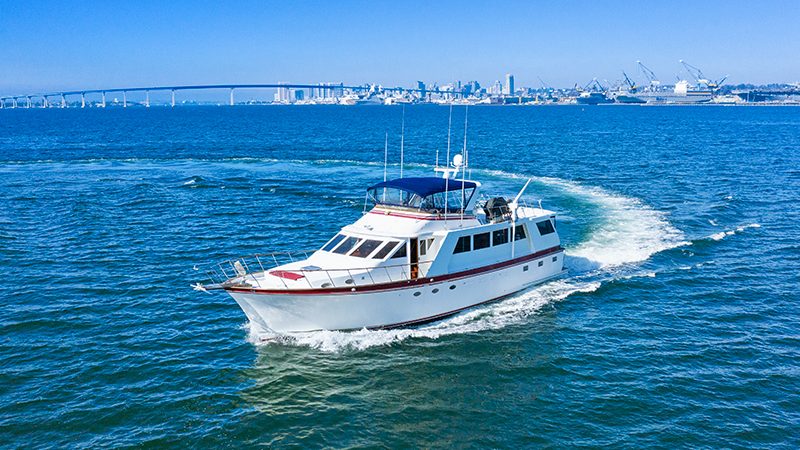
Who Are the Five Good Jibes Spracht BoneHead Headset Winners?
Throughout October we celebrated the one-year anniversary of our Good Jibes podcast by giving listeners the chance to win one of five sets of Spracht BoneHead Sport headsets. The entry requirement was simple — sign up for the weekly Good Jibes newsletter between October 1 and 31.
On Wednesday morning we drew five winners from the list of new subscribers and sent them an email. We need to hear back from you if you want to claim your prize.
So far we have a reply from Grant Du Plooy. “Thanks for letting me know about my BoneHead win. I can’t wait to try it out on the new Jeanne Socrates podcast!”
Congratulations, Grant. Your BoneHeads are on their way!
If you received an email with the subject line “Congratulations! You won!” reply to us before next Friday, November 11, with your name and mailing address so we can get your headset mailed out to you. Otherwise we’ll have to redraw for your prize.

The BoneHead bone-conduction headsets go around your ears, not in them, so you can still hear what’s going on around you while you listen to your Good Jibes podcast or your favorite sailing songs. If you didn’t win, but really want a pair, you can order them here: Spracht BoneHead Sport™.
Good Jibes brings you the world of sailing through the eyes (and ears) of the West Coast sailor. Each week, you’ll hear stories and tips from the West Coast sailing community on cruising, racing and just plain sailing. Cast off, laugh, and learn, and become a better sailor. Hosted by the team at Latitude 38 — the sailing magazine for West Coast sailors since 1977!
West Coast J/24 Sailors Go East for North Americans
A cast of San Francisco Bay Area racers traveled to participate in the 2022 J/24 North American Championship and J/22 East Coast Championship. Severn Sailing Association hosted the regatta in Annapolis, MD, last weekend, October 26-30. Bay Area J/24 fleet captain Jasper Van Vliet entered his East Coast boat, Evil Twin, into the Corinthian racing fray. He’s a stalwart on the lefthand side of the US aboard Evil Octopus. Other Evil teamers heading right on the map included Eleanor (Ellie) Tubman at foredeck, Charlie McKenzie at mast and William Pochereva on trim. “I met these three at the Richmond Yacht Club beer can series,” says a smiling Van Vliet. “Tactician Mays Dickey joined too, enlisted via the J/24 network. Each is brilliant. I hesitate to name them for fear of being poached.”
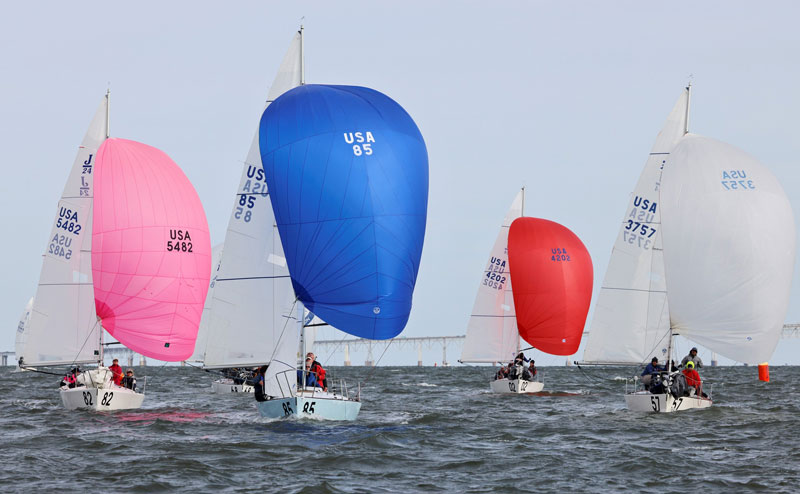
San Francisco sailor Laura Graham also traveled east. She joined up with her mates on Sea Bags Women’s Sailing Team, based out of Portland, ME.
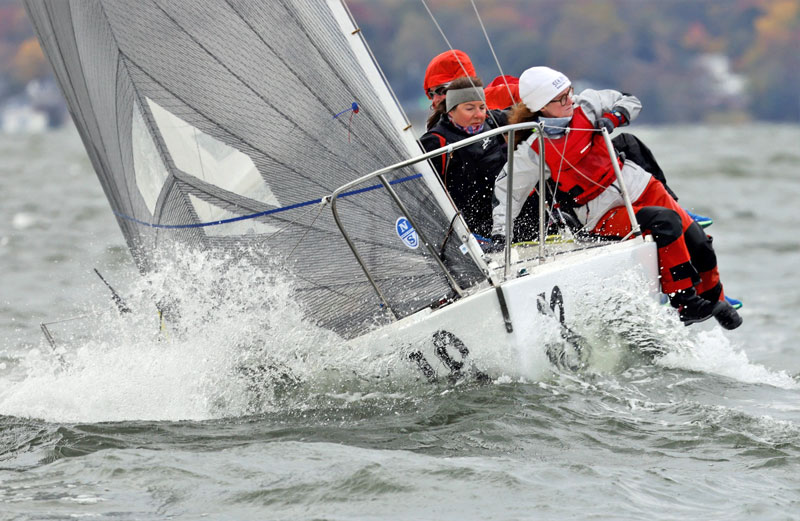
After seven races, Evil Twin finished in 12th place, Sea Bags in 13th. Reveals Van Vliet, “Evil Twin made two basic rookie mistakes on Friday: We didn’t manage our starts correctly (not enough pre-race checklist stuff), and we convinced ourselves to keep the rig tune very soft (our practice day showed massive light periods in an otherwise windy day). By Saturday we had figured out both problems and remedied things, which then yielded decent starts and good boat speed and height.”
Saturday delivered stiff NNE winds in the morning and plenty of chop, tapering off to around 8 knots by the afternoon. Organizers attempted to run one more race, but after a few starts and general recalls in 5-knot winds, they called it a day. Van Vliet thinks back, “We motored to the start, sailed around in light air waiting for a start, then motored back.” After this, Team Evil “took out the boat, dropped the rig, then went into town for ice cream and fudge — try the Cookie Monster flavor. It’ll turn your face blue.”
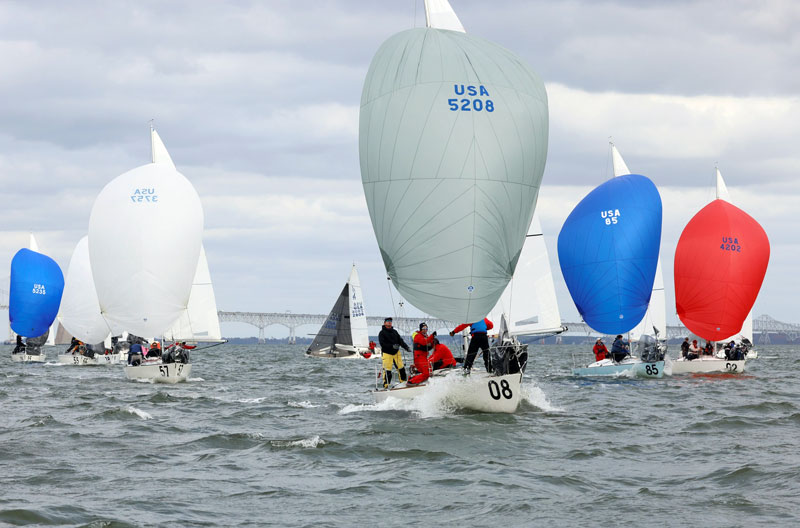
Two crews from Japan, plus a few more from Latin America and Canada, heard about the party also. That equated to a tally of more than 300 small-boat fans sitting on 45 different J/24s and 13 J/22s. See complete results here.
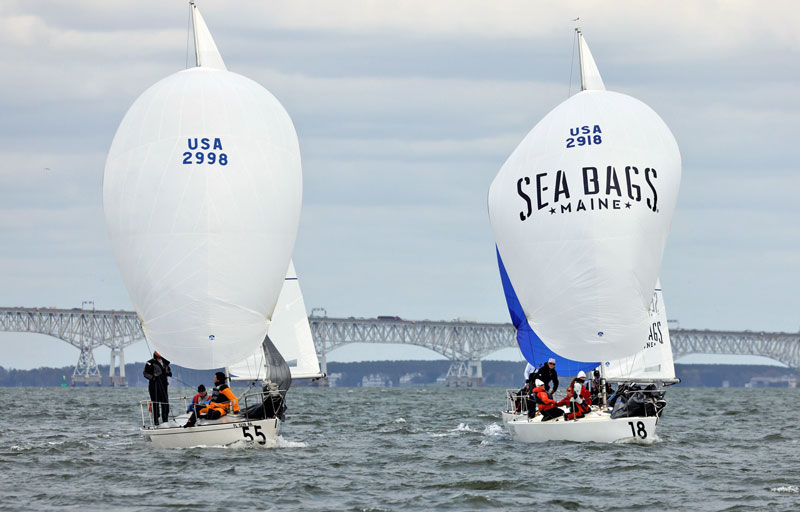
Van Vliet has been active as crew in the Bay Area J/24 fleet since 1998, eventually purchasing his own boat in 2011. “The fleet in San Francisco has seen a lot of turnover since then, and we’ve been trying to create more of a family feel to make it a more attractive fleet to join. We’ve had some success with that. Many of the J/24 skippers socialize outside of sailing. We also often crew on each other’s boats or help one another find crew.”
Online Yacht Auction of 1985 Ocean Alexander 70
Online Yacht Auction of 1985 Ocean Alexander 70. Online bidding starts Tuesday, November 8, 2022. Panoramic tour and extensive photo gallery available at www.WestAuction.com.
Why Is San Diego Bay More Welcoming Than San Francisco Bay?
When we travel to San Diego for the annual start of the Baja Ha-Ha, one of the things we marvel at is the coordination and collaboration of the many agencies that share jurisdiction and responsibilities around San Diego Bay. At times it can feel bureaucratic, but the result is a bay that is terrific at welcoming visiting sailors and, compared to San Francisco, does a much better job managing the shoreside services needed for boaters. On San Francisco Bay we’ve witnessed the 40+ year battle with anchor-outs on Richardson Bay and elsewhere. San Diego Bay has managed to find a regulated compromise, with both anchorage areas and 462 moorings managed by the San Diego Mooring Company available to rent. According to Vanessa Hoffman of the San Diego Mooring Company, all the boats on moorings are required to be registered or Coast Guard-documented, and must have liability insurance for wrecks or oil spills, naming the San Diego Mooring Company as additional insured. All boats must also have a free, once-per-year Coast Guard Auxiliary inspection for seaworthiness.
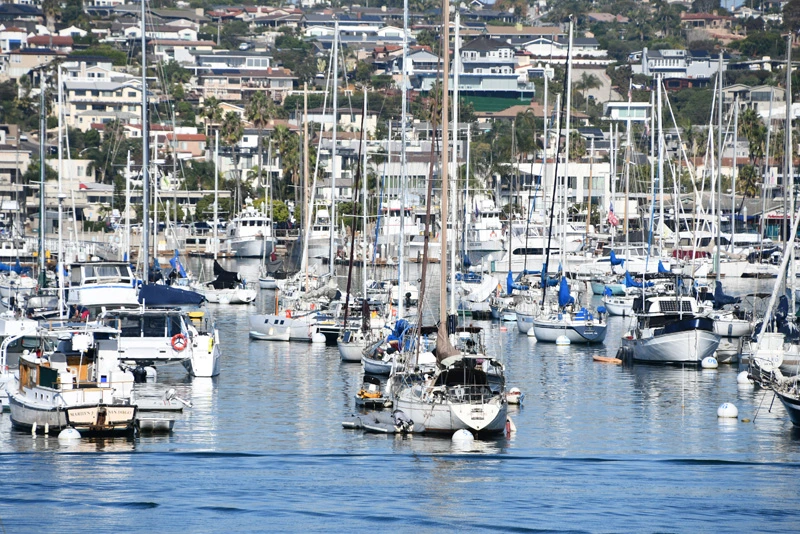
Conditions are indeed more benign in San Diego, so mooring fields are easier to set up and maintain, but there are successful mooring fields along the snowy coast of Maine, with 12-foot tides, and throughout the far northern reaches of Europe. It’s also true that there were many more boats anchored and moored throughout San Francisco Bay from the 1840s to perhaps the 1950s. Recreational sailing was enjoyed by many long before the first marina was ever built.
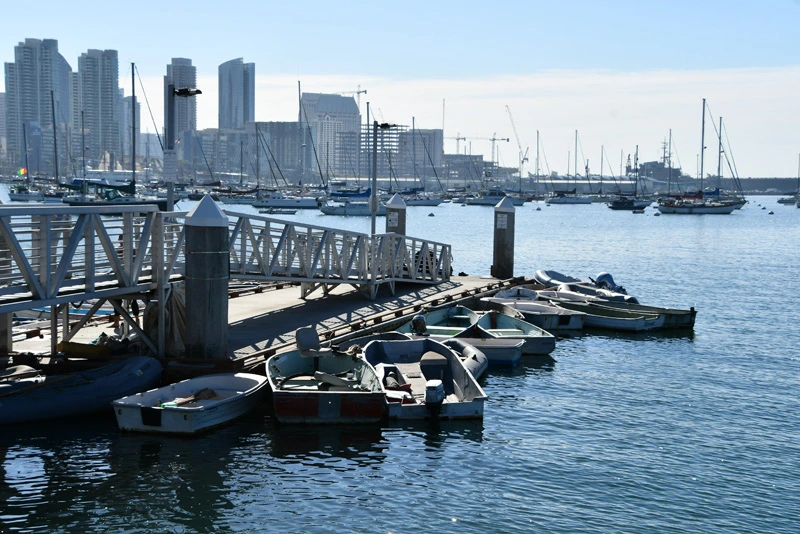
Cruising into San Diego Bay on your way south to Mexico is generally a welcoming experience. Cruisers pull into the Harbor Police Dock at the end of Shelter Island, which is staffed with Harbor Police who work with sailors and boaters daily. The Harbor Police Dock has 26 slips, up to 65 feet in length, where cruisers can stay for up to 15 days out of 40. The Harbor Police can direct and permit cruisers to anchorages, and help cruisers find space around the bay. Finding space can be tricky because most marinas are full, with waiting lists, making it especially helpful to have a public agency that understands the needs of transient cruisers. If you google San Diego Harbor Police you’ll find their website and lots of helpful information for visiting sailors. Googling San Francisco, Alameda or Sausalito Harbor Police, we couldn’t easily find anything useful for visiting sailors. The Port of San Diego and the San Diego Working Waterfront work hard to protect and promote recreational boating amid a densely populated urban setting.
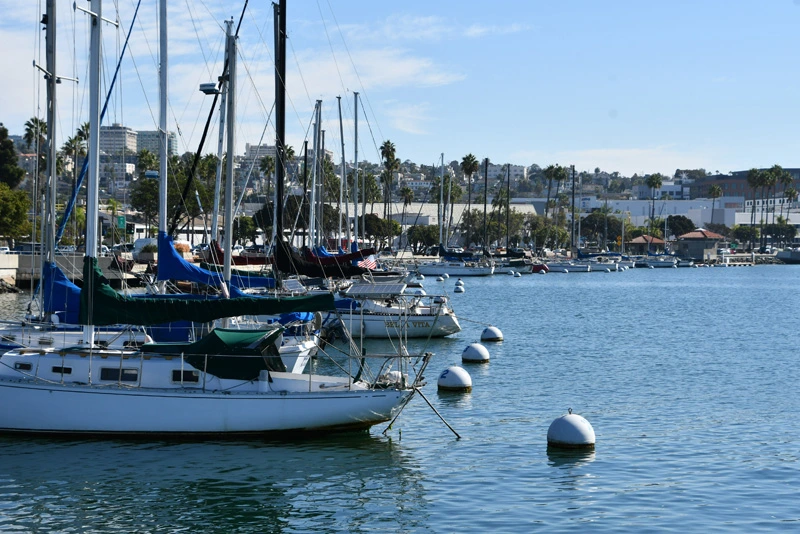
Does San Francisco Bay actually need or want temporary or permanent moorings? Ayala Cove is a good example of how a well-managed mooring field can be a boon for boating and boaters. It’s one of the Bay’s few protected coves that benefits from allowing the safer, more densely spaced and more environmentally friendly mooring balls on the Bay. It has a dinghy dock for visitors, providing easy access to the shore. One of the best places for a mooring field would be the endlessly controversial Richardson Bay. Mooring fields protect eelgrass by reducing anchoring, and allow for better management of the anchorage. Day-use moorings could also exist on the east side of Angel Island, or off Paradise Cove or China Camp. There’s room for mooring fields in the Oakland Estuary, and likely along the east shore of the San Francisco Peninsula.
Yacht clubs and marinas pick up the slack where municipalities fall short, but this misses some of the benefits of having municipalities involved in their waterfronts. The marinas on San Francisco Bay would also benefit, as boaters would have more options for boat usage. This in turn would create a more boating-friendly culture with their local communities, and create better connections with municipal governments that often see waterfronts only as development opportunities, rather than as a recreational and healthy lifestyle benefiting all citizens.
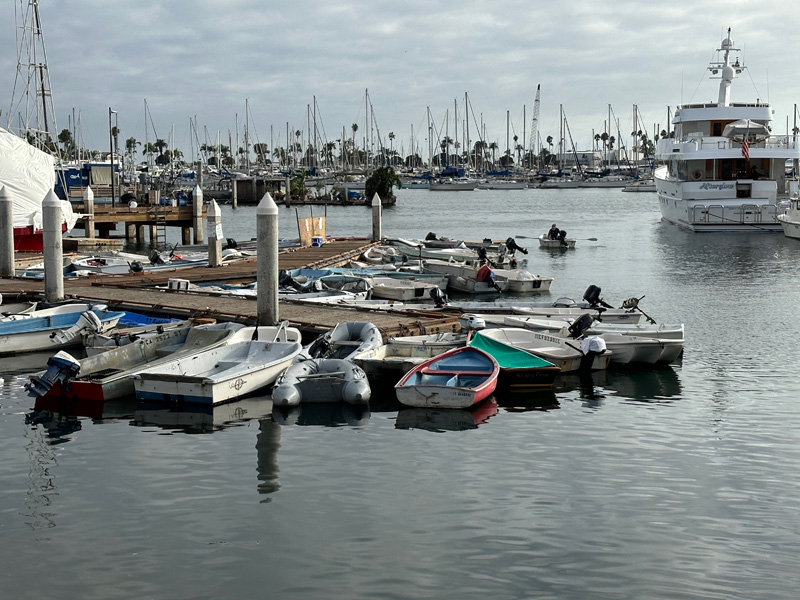
Welcoming anchorages, mooring fields and dinghy docks are features of most waterfront communities along most of America’s coastlines. Despite being a fabulous sailing mecca, San Francisco Bay appears to have a unique deficit of welcoming facilities for visiting boats, or for encouraging local sailors to cruise San Francisco Bay. Bay Area municipalities would benefit their residents and the character of their towns by providing more welcoming facilities to visiting boats, whether they’ve come from Seattle or are simply local cruisers exploring the Bay. San Diego hasn’t solved all the challenges faced in managing limited harbor space in a congested urban area. But the agencies, businesses and communities involved work well together and appear to be far ahead of San Francisco Bay when it comes to welcoming visiting sailors or providing services for local anchoring, mooring and recreational boating access.
The Remote Encounters and Recent History of San Miguel Island
Stepping onto a boat has, for me, always felt like stepping onto a spaceship. Taking an airplane is more like stepping into the “transporter” and getting “beamed” down to a planet: In a blur, you’re there. But on a boat, you can perceive your slow motion across the vast reaches of an abyss. You have a routine and carve out a little life for yourself on the boat.
I woke up around 8 a.m. in late October 2020 as San Miguel Island sat squarely to starboard of the Kelly Peterson Esprit. Motoring on glassy seas, we anchored, drank coffee and canned Mai Tais, and swam in the clear, cold water. We had arrived to “unusual conditions” in Cuyler Harbor — anything less than 25 knots blowing 24/7 was considered “unusual.” Calm and warm in the sun, it was easy to forget San Miguel’s delicate perch on the edge of a continent. But reminders abound.
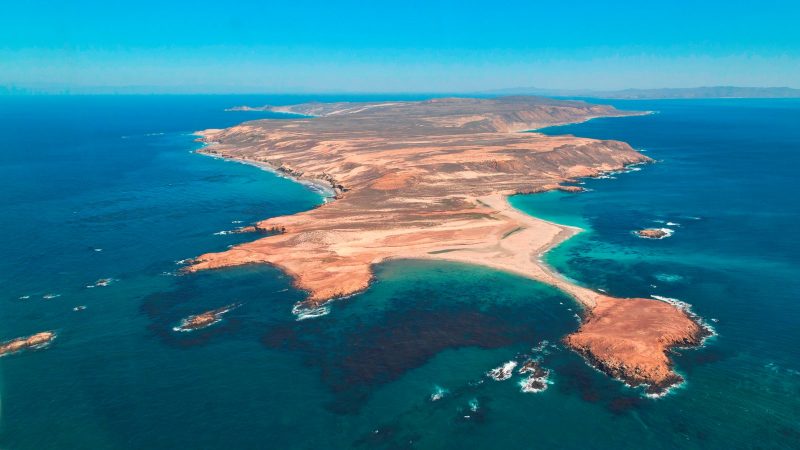
About five million years ago, the Channel Islands were kind of spit out of the West Coast of North America. Looking at the tall peaks on San Miguel, it was easy to imagine plate tectonics, geysers of liquid hot magma, and the fiery innards of the Earth rising into islands and mountains.
We took to the water in a small inflatable armada in October 2020, paddling from Esprit to the beach. A short hike through a small canyon took us to a mesa and the ranger station, complete with a volunteer ranger who came out to say hello. (It being 2020, we all stood at what even now would seem like an unnatural distance from the ranger.) If memory serves, we met two researchers who were tagging and tracking the island fox, a tiny, genetically isolated cousin of the mainland variety. We hiked over the empty campground, and would later see a boat driving to the beach and unloading a gaggle of campers.
Every time I’m tempted to use the adjective “remote” to describe San Miguel, I remind myself that there is literally a “bus” from L.A. County dropping off people on the beach.
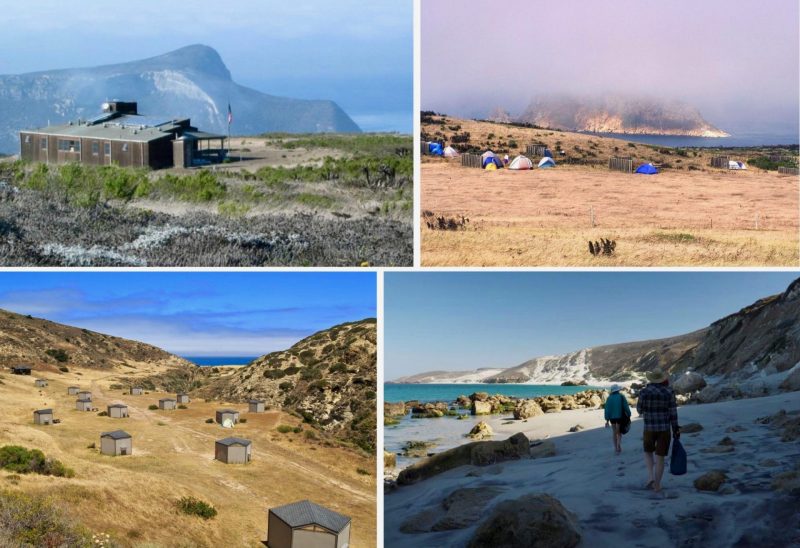
We eventually found a monument and plaque honoring Juan Rodríguez Cabrillo (who was believed to have died on San Miguel) and “the first recorded European voyage” to the Channel Islands in 1542. The year 2020 saw a kind of reckoning over legacies and history, and challenges to the notion of discovery. (There is also a debate over whether Cabrillo was from Spain, or rather, was João Rodrigues Cabrilho from Portugal.)
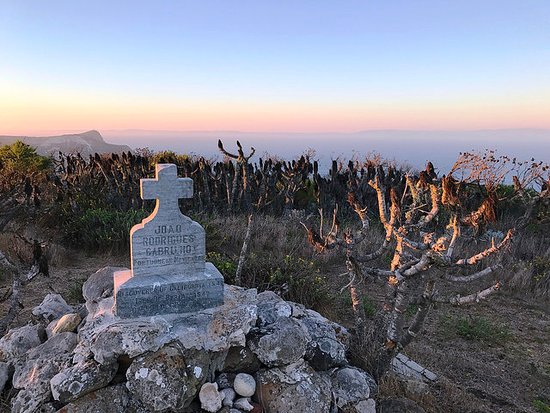
As a rule, California is named for the Europeans who settled and colonized it, and not for the indigenous people. “Some of the oldest human remains known in North America were discovered [on the Channel Islands],” said narrator Kevin Costner in the short documentary Channel Islands National Park — Treasure in the Sea. “The native Chumash people were one of the most advanced societies of their time,” Costner said in Treasure in the Sea. According to the National Park Service, “Approximately 148 historic [Chumash] village sites have been identified, including 11 on Santa Cruz Island, eight on Santa Rosa Island, and two on San Miguel Island.” (San Miguel is known as “Tuqan” to the Chumash.)
To me, history has always come down to digestibility. Given its recent past, written documentation in a Latin-based language, artist’s renderings and celebrated explorers, the Europeans have understandably dominated the historical narrative. By contrast, the spoken history of Native Americans and Polynesians, which is generally absent a central, heroic figure, has evaporated.
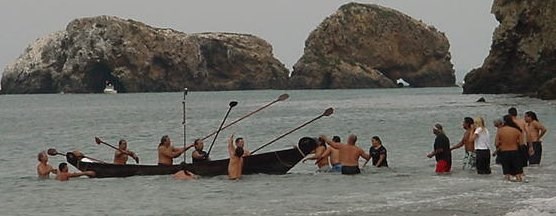
“San Miguel: An island of extremes. Wild, windy and remote.”
Given the aforementioned “busload” of campers and the mellow conditions, San Miguel didn’t feel wild or remote, or rather, with good weather and a few boats in the harbor, one could easily forget their delicate perch on this delicate perch.
Mitch Andrus, Quincey Cummings, Brian Cline and I had planned to leave for Santa Rosa on a calm afternoon, but when we tried to weigh anchor, the windlass would spin for moments, then nothing. Mitch got his tools and began diagnosing the winch with the optimism of any good boat owner. As happens so often in cruising, our plans became fluid; we would leave the next day.
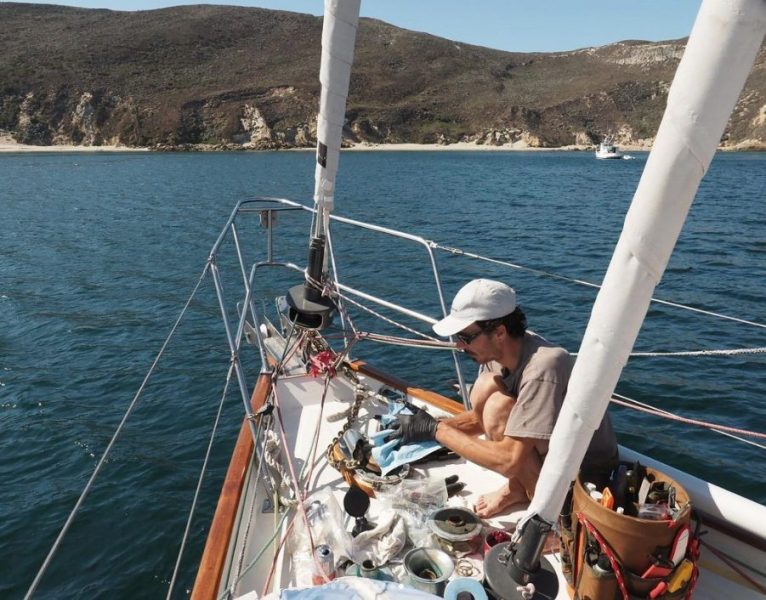
The Short Happy Life of Chirpy McVonstein
I don’t remember at what point on San Miguel we had “poured one out” for a lost and unexpected member of our crew.
On day two of our sail from the Bay to the Channel Islands, a small bird circled the boat, landed on deck, and won us all over with his(?) gregariousness. We immediately offered him handfuls of seeds and nuts, and within minutes, he was jumping onto our bowls while we ate dinner. We named him “Chirpy” because he was chatty, and I added the most absurd surname I could think of.
Panda, Mitch and Quincey’s cat, took a different kind of interest in our visitor, but we discouraged too much curiosity, which, of course, can kill.
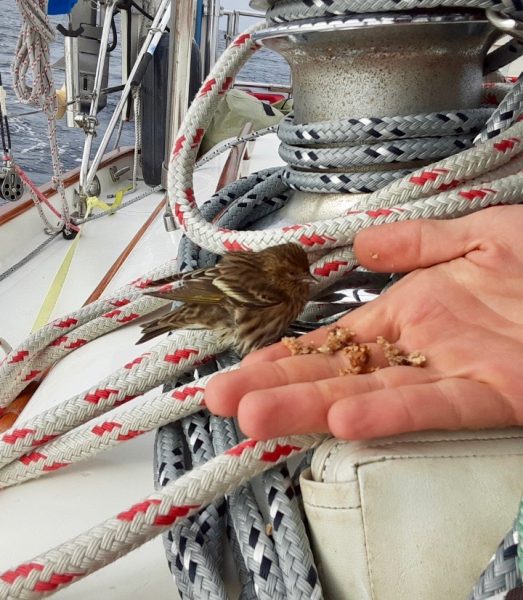
We were all a little concerned at Chirpy’s audaciousness, and were relieved when, after making a few aerial laps around the boat and landing again, he seemed to depart for good. In the months after the trip, we would hear several stories about birds befriending boats transiting the California coast, with crews surprised and delighted at the forwardness of the winged visitors. Most of these boats probably didn’t have cats, though.
Less than 24 hours later, as we were waking up at anchor in Morro Bay, I heard Panda Cat bouncing around. Looking down at the cabin sole, I saw an ominous trail of feathers, and the lifeless body of Chirpy.
Lesson learned: Had any of us known how this would end, we would have (obviously) shooed Chirpy away immediately, but we were thoroughly charmed by him and didn’t know that we needed to protect him from his own sociability. (On a calm morning in Cuyler Harbor, a small seal swam up to Brian, who was sitting on a SUP, and hung out for a while. We, as sailors, cherish these kinds of encounters — it’s why we go sailing. We wondered if we could feed the little seal something, when Quincey said, “Remember what happened the last time we fed wildlife?”)
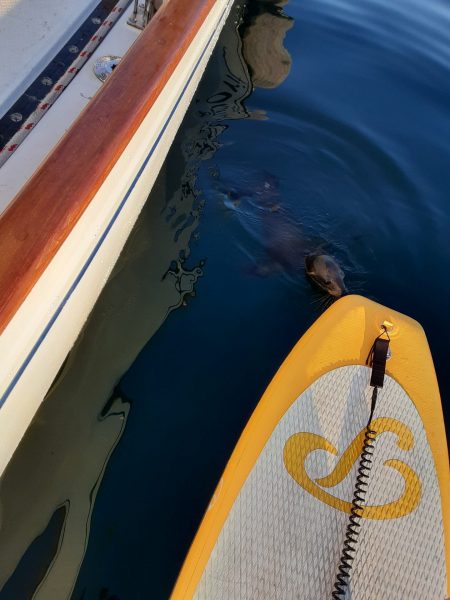
Change of Plans, Part 2
The 25 knots famous for blowing 24/7 on San Miguel arrived in the middle of a moonlit night, and I awoke to news that we were dragging anchor and headed for a reef.
In an instant, we felt the “remoteness” of San Miguel, and the stakes were suddenly much higher.
The windlass would spin and stop, spin and stop. We had a handle to crank the winch manually, but it was prohibitively slow. Brian pulled the anchor chain by hand, while I fed the excess chain into the anchor locker.
It was sketchy. (I think there was some consideration of abandoning the anchor and chain.) The wind howled, and Esprit bobbed on the short, moonlit chop. It felt as if we could see ourselves moving against the island. We kept trying the windlass, and it would work in tiny bursts, before it finally spun for long moments and gathered some 50 feet of chain.
Before we knew it, we were free, bound for Santa Barbara.
We had good wind on the beam, and went from stuck to gloriously free and broad-reaching in an almost imperceptible interval. The waxing gibbous moon set behind us as we headed for the dim lights of the mainland, behind which the sun rose a few hours later. Streaks of phosphorescence torpedoed toward the boat, then swam with us, and we took turns at the bow watching dolphins (or porpoise?) watching us from just beneath the water.
In my 30 years at sea, it was one of my favorite moments.

